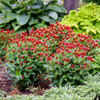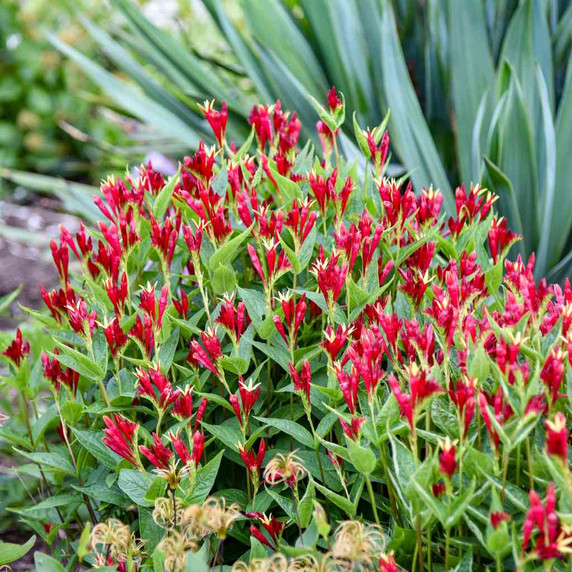Spigelia marilandica 'Little Redhead' - INDIAN PINK 'LITTLE REDHEAD' (rich blooming, upright, dark red)
Superior selection of southeastern native woodland-edge perennial.
More compact than the species, upright, rich blooming with dark red flowers with yellow throats.
Hummingbird plant with versatile use : tolerates more sun and can be planted in full sun (with average moisture), but appreciates some shade during the day (especially in the Deep South)
Tough, heat and humidity tolerant plant.
Long-lived clump perennial with somewhat ground covering growth.
Blooming Time: early June to mid to late July
Size: 24-28" high x 20-24" wide
USDA Zones: 5b to 9
Culture: full sun, half shade, shade, dappled to light shade, best if grown in rich soils with some organic material (leafy compost, decaying leaves, fine mulch, compost), but is adaptable to loamy, sandy and clay soil too. This perennial is also fairly drought tolerant, once established. Tolerant to heat and humidity
Moisture Needs: medium-dry, medium, medium-moist to wet
Origin: this clonaly propagated selection originates in Woodlanders Nursery (Bob McCartney).
The species of S. marilandica is native to the eastern United States from Maryland to the Florida, and west to Missouri, Oklahoma and Texas. Usually found in high quality natural areas in clearings, moist woodlands, edges, bottom land forests, swamp borders, shaded creek banks etc.
Black Walnut Tolerant: yes
Deer/Rabbit Resistant: yes/yes
Attracts Butterflies or Pollinators: some butterflies
Attracts Hummingbirds: yes, favorite hummingbird plant
Pot Size: round Proven Winner quart 4.25" x 5" deep pot
Plant combination: Spigelia looks great combined with half shade perennials like Chrysogonum virginianum, Geranium maculatum, Heuchera, Iris cristata, Maianthemum, Phlox divaricata or stolonifera, Polemonium reptans, Polygonatum, Stylophorum divaricatum, Tiarella cordifolia or woodland asters, sedges or smaller ferns. Non-native perennial companions will also work fine – Aruncus, Bergenia, Brunnera, Epimedium, hardy Geraniums, Hosta, Hakonechloa, Heucherella, Ligularia, Persicaria, Waldsteinia.
et's mention at least Achillea, Amsonia, Baptisia, Echinacea, hardy Geraniums, Hemerocallis, various irises, shorter Lilium, Paeonia, tall Phloxes and hybrids, Rudbeckia, tall Sedum, tall Veronica, Veronicastrum and many other plants and medium-sized grasses.
Picture copyright: Walters Gardens

Spigelia marilandica 'Little Redhead' - INDIAN PINK 'LITTLE REDHEAD' (rich blooming, upright, dark red)
Superior selection of southeastern native woodland-edge perennial.
More compact than the species, upright, rich blooming with dark red flowers with yellow throats.
Hummingbird plant with versatile use : tolerates more sun and can be planted in full sun (with average moisture), but appreciates some shade during the day (especially in the Deep South)
Tough, heat and humidity tolerant plant.
Long-lived clump perennial with somewhat ground covering growth.
Blooming Time: early June to mid to late July
Size: 24-28" high x 20-24" wide
USDA Zones: 5b to 9
Culture: full sun, half shade, shade, dappled to light shade, best if grown in rich soils with some organic material (leafy compost, decaying leaves, fine mulch, compost), but is adaptable to loamy, sandy and clay soil too. This perennial is also fairly drought tolerant, once established. Tolerant to heat and humidity
Moisture Needs: medium-dry, medium, medium-moist to wet
Origin: this clonaly propagated selection originates in Woodlanders Nursery (Bob McCartney).
The species of S. marilandica is native to the eastern United States from Maryland to the Florida, and west to Missouri, Oklahoma and Texas. Usually found in high quality natural areas in clearings, moist woodlands, edges, bottom land forests, swamp borders, shaded creek banks etc.
Black Walnut Tolerant: yes
Deer/Rabbit Resistant: yes/yes
Attracts Butterflies or Pollinators: some butterflies
Attracts Hummingbirds: yes, favorite hummingbird plant
Pot Size: round Proven Winner quart 4.25" x 5" deep pot
Plant combination: Spigelia looks great combined with half shade perennials like Chrysogonum virginianum, Geranium maculatum, Heuchera, Iris cristata, Maianthemum, Phlox divaricata or stolonifera, Polemonium reptans, Polygonatum, Stylophorum divaricatum, Tiarella cordifolia or woodland asters, sedges or smaller ferns. Non-native perennial companions will also work fine – Aruncus, Bergenia, Brunnera, Epimedium, hardy Geraniums, Hosta, Hakonechloa, Heucherella, Ligularia, Persicaria, Waldsteinia.
et's mention at least Achillea, Amsonia, Baptisia, Echinacea, hardy Geraniums, Hemerocallis, various irises, shorter Lilium, Paeonia, tall Phloxes and hybrids, Rudbeckia, tall Sedum, tall Veronica, Veronicastrum and many other plants and medium-sized grasses.
Picture copyright: Walters Gardens






